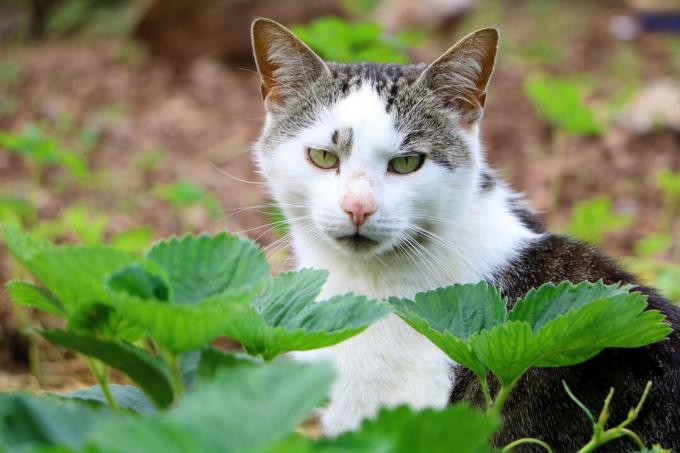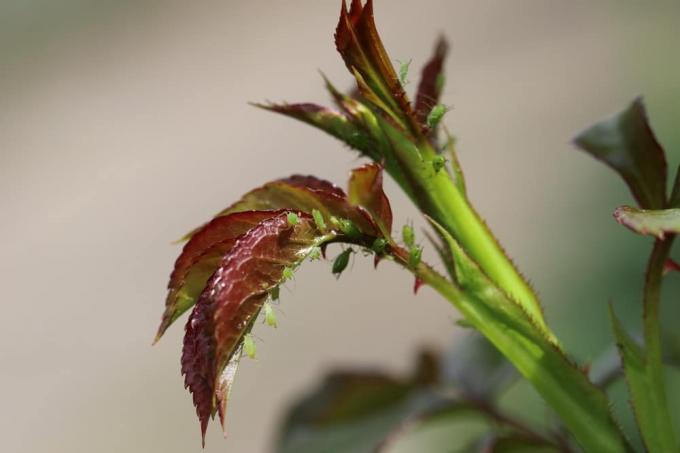

Table of contents
- Identify mole crickets
- Harmfulness of the mole cricket
- Food of mole crickets
- spread of insects
- Fighting the Werre
- attract predators
- nematodes
- create traps
- destroy buildings
- pesticides and home remedies
The mole cricket is considered endangered and, like the field cricket, rarely causes damage to plants. Instead, it is beneficial as long as there is sufficient other food available.
Identify mole crickets
Identifying the warts is not easy, as both eggs and larvae and adults are in the ground. Although the adult insects can also fly, they only spend a fraction of their lives above the surface of the earth. They can be recognized by the following characteristics:
- dark brown to black colour
- armored head
- Size of up to seven centimeters
- Habitat often near bodies of water, under lawns or in compost
- nocturnal
- strong front legs
Tip:
Due to the similarity to the field cricket and the nocturnal activity, the distinction and recognition can often be difficult, especially for laypeople. Even the chirping is only noticeable for a short time a year. However, this only applies if only a few copies are available.
Harmfulness of the mole cricket
Normally, this species of cricket is a beneficial creature that is unfortunately still endangered. In small numbers and with sufficient food, they do not cause any damage. However, if the population gets out of hand and the preferred food is no longer available in sufficient quantities, the following problems can arise:
- gnawed root vegetables and tubers
- excavated seedlings
- Mounds and dug-up areas on beds
- Holes and discoloration in the lawn
- damage to plant roots
Tip:
The mole cricket is mainly found in natural gardens, but is usually not noticeable here. If a natural corner with tall grass and compost is missing, problems will arise more quickly and show up early.
Food of mole crickets
As a rule, crickets feed on animal food. For example:
- larvae
- insect eggs
- maggots
- snail eggs
- worms
If possible, these are even created as reserves in the underground passages. However, if there is not enough animal food, the crickets will switch to plant roots and root vegetables. The result is holes in the tubers and growth that seems to be inexplicably dying. This happens, for example, when the preferred food sources are overused by too many animals insufficient quantities of the pests are available or due to pesticide control stand.
spread of insects
The Mole Grill or Werre was named after their way of life. Although the insects can even swim, they mainly live in the tunnels they dig themselves. This is where they find their food, build up supplies and lay eggs.
These corridors and structures have the following characteristics, among others:
- can reach lengths of up to 30 meters
- partly recognizable by holes or small mounds of earth
- Depth from five to 30 centimeters
From the outside or above, these structures of the crickets are often extremely inconspicuous and difficult to recognize for laypeople.
Fighting the Werre
When mole crickets appear in large numbers, they can pose a problem. It then makes sense to fight or at least expel them. This can be achieved in different ways.
attract predators
The natural predators of the mole cricket include:
- ants
- Chicken
- Hedgehog
- cats
- moles
- shrews

Attracting or keeping these animals is also advisable for other reasons. They are generally favorable for a balance of living beings in the garden. Designing natural areas helps to attract the animals. This includes, for example:
- Making grass grow taller in a corner
- to build a pile of wood
- to create a pond
Tip:
Beneficial insects can also cause damage in the garden. With a stable balance of the fauna, however, the animals regulate each other.
nematodes
In the case of a very heavy infestation with mole crickets, the use of nematodes is recommended. These use the adult insects as hosts, penetrate them and gradually kill them. Steinernema Carpocapsae nematodes are not effective against larvae and eggs, but they can significantly reduce the mole cricket population.
If they can no longer find food, they die and are therefore not a problem or a burden. It may be necessary to repeat application of the nematodes as more larvae hatch and grow. The nematodes or roundworms are available both in specialist shops and online.
create traps
If the infestation is low, it is possible to introduce humane traps and then release the crickets far away. This does not further decimate the endangered animals, but does not cause any damage either.
The procedure for deploying the traps is as follows:
- Provide preserving jars or other containers that are as deep as possible. These must have a smooth inside.
- Dig the containers deep enough into the ground so that the top edge is flush with the surface of the earth. The opening must of course remain free.
- It is often recommended to place a wooden stick vertically in the glass. In this way, the insects should be able to get in but not out again. However, this is often not the case. Because a branch or a bar can also be used as an escape route. In addition, the insects can fly and move up easily thanks to their strong and rough front legs.
Tip:
Containers that are as narrow and deep as possible are particularly suitable. This means that climbing out or flying out is no longer so easy. They should be checked early in the morning and emptied if necessary. However, this method is usually not really effective.
destroy buildings
When the Werre has settled in its own garden, it also creates breeding caves here. These can be found by using a staff and checking the holes and corridors. Ducts that are nearly vertical suggest underlying eggs or larvae.
These should be dug up with a spade and destroyed if the infestation is very severe. Alternatively, relocation to another location is possible. For example, the compost heap is suitable.
pesticides and home remedies
In addition to the recommended means and measures, there are also pesticides and household remedies. However, these pollute the environment and often also other beneficial organisms, which means that they should not be used.
 garden editorial
garden editorial I write about everything that interests me in my garden.
Learn more about pests

Identifying wood pests: overview
In nature, insects that break down wood make a valuable contribution. If the wood is a roof truss, for example, the insect becomes a pest that must be combated in order to avoid expensive damage.

Combat Whitefly | 11 home remedies for whiteflies
The whitefly is a tiny creature whose presence on our plants can have unpleasant effects. If a few specimens come across a healthy garden, there is hardly anything to fear. If the flies are there in droves, proven home remedies must be used immediately.

Ant remedy | 13 natural remedies against ants
Ants are more than annoying bugs. In nature, they contribute to the preservation of the forest and keep pests away. If they undermine the terrace slabs in the garden or penetrate into the house, they must be fought. Which natural remedies are effective?

How does ant spray work? Is it toxic to humans?
Many people use special sprays from well-known manufacturers when fighting ants. Their effect is indeed efficient. However, these synthetic agents not only have advantages but also disadvantages in terms of environmental impact and health. It is therefore advisable to resort to natural means.

Drive away cockchafers: recognize grubs | 5 natural enemies
"Fly maybeetle!" says an old children's song about death and destruction. In fact, the larvae of the cockchafer, the grubs, can cause considerable damage in some years. How to fight the plague with natural means.

13 home remedies against aphids: coffee grounds, garlic, tea tree oil & Co
There are a variety of household remedies that will get rid of aphids. Many products are available in every household. A watery solution can be prepared in just a few steps and sprayed directly onto the plant.



